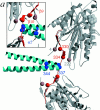Controlling kinesin by reversible disulfide cross-linking. Identifying the motility-producing conformational change
- PMID: 11086009
- PMCID: PMC2174365
- DOI: 10.1083/jcb.151.5.1081
Controlling kinesin by reversible disulfide cross-linking. Identifying the motility-producing conformational change
Abstract
Conventional kinesin, a dimeric molecular motor, uses ATP-dependent conformational changes to move unidirectionally along a row of tubulin subunits on a microtubule. Two models have been advanced for the major structural change underlying kinesin motility: the first involves an unzippering/zippering of a small peptide (neck linker) from the motor catalytic core and the second proposes an unwinding/rewinding of the adjacent coiled-coil (neck coiled-coil). Here, we have tested these models using disulfide cross-linking of cysteines engineered into recombinant kinesin motors. When the neck linker motion was prevented by cross-linking, kinesin ceased unidirectional movement and only showed brief one-dimensional diffusion along microtubules. Motility fully recovered upon adding reducing agents to reverse the cross-link. When the neck linker motion was partially restrained, single kinesin motors showed biased diffusion towards the microtubule plus end but could not move effectively against a load imposed by an optical trap. Thus, partial movement of the neck linker suffices for directionality but not for normal processivity or force generation. In contrast, preventing neck coiled-coil unwinding by disulfide cross-linking had relatively little effect on motor activity, although the average run length of single kinesin molecules decreased by 30-50%. These studies indicate that conformational changes in the neck linker, not in the neck coiled-coil, drive processive movement by the kinesin motor.
Figures







Similar articles
-
Role of the kinesin neck region in processive microtubule-based motility.J Cell Biol. 1998 Mar 23;140(6):1407-16. doi: 10.1083/jcb.140.6.1407. J Cell Biol. 1998. PMID: 9508773 Free PMC article.
-
Engineering the processive run length of the kinesin motor.J Cell Biol. 2000 Nov 27;151(5):1093-100. doi: 10.1083/jcb.151.5.1093. J Cell Biol. 2000. PMID: 11086010 Free PMC article.
-
Structural links to kinesin directionality and movement.Nat Struct Biol. 2000 Jun;7(6):456-60. doi: 10.1038/75850. Nat Struct Biol. 2000. PMID: 10881190 Review.
-
Neck linker length determines the degree of processivity in kinesin-1 and kinesin-2 motors.Curr Biol. 2010 May 25;20(10):939-43. doi: 10.1016/j.cub.2010.03.065. Epub 2010 May 13. Curr Biol. 2010. PMID: 20471270 Free PMC article.
-
Directionality of kinesin motors.Acta Biochim Pol. 2002;49(4):813-21. Acta Biochim Pol. 2002. PMID: 12545188 Review.
Cited by
-
Kinesin-2 motors: Kinetics and biophysics.J Biol Chem. 2018 Mar 23;293(12):4510-4518. doi: 10.1074/jbc.R117.001324. Epub 2018 Feb 14. J Biol Chem. 2018. PMID: 29444824 Free PMC article. Review.
-
Engineering tubulin: microtubule functionalization approaches for nanoscale device applications.Appl Microbiol Biotechnol. 2011 Apr;90(1):1-10. doi: 10.1007/s00253-011-3140-7. Epub 2011 Feb 16. Appl Microbiol Biotechnol. 2011. PMID: 21327409 Free PMC article. Review.
-
Single molecule FRET observation of kinesin-1's head-tail interaction on microtubule.Biophysics (Nagoya-shi). 2013 Nov 7;9:149-59. doi: 10.2142/biophysics.9.149. eCollection 2013. Biophysics (Nagoya-shi). 2013. PMID: 27493553 Free PMC article.
-
A conserved tyrosine in the neck of a fungal kinesin regulates the catalytic motor core.EMBO J. 2003 Feb 3;22(3):450-8. doi: 10.1093/emboj/cdg036. EMBO J. 2003. PMID: 12554646 Free PMC article.
-
Single molecule mechanics of the kinesin neck.Proc Natl Acad Sci U S A. 2009 Apr 28;106(17):6992-7. doi: 10.1073/pnas.0812620106. Epub 2009 Apr 14. Proc Natl Acad Sci U S A. 2009. PMID: 19369199 Free PMC article.
References
-
- Block S.M. Kinesinwhat gives? Cell. 1998;93:5–8. - PubMed
-
- Block S.M., Goldstein L.S.B., Schnapp B.J. Bead movement by single kinesin molecules studied with optical tweezers. Nature. 1990;348:348–352. - PubMed
-
- Case R.B., Pierce D.W., Hom-Booher N., Hart C.L., Vale R.D. The directional preference of kinesin motors is specified by an element outside of the motor catalytic domain. Cell. 1997;90:959–966. - PubMed
-
- Case R.B., Rice S., Hart C.L., Ly B., Vale R.D. Role of the kinesin neck linker and catalytic core in microtubule-based motility. Curr. Biol. 2000;10:157–160. - PubMed
-
- Chandrasekhar S. Stochastic problems in physics and astronomy. Rev. Mod. Phys. 1943;15:1–89.
Publication types
MeSH terms
Substances
Grants and funding
LinkOut - more resources
Full Text Sources
Other Literature Sources
Research Materials

